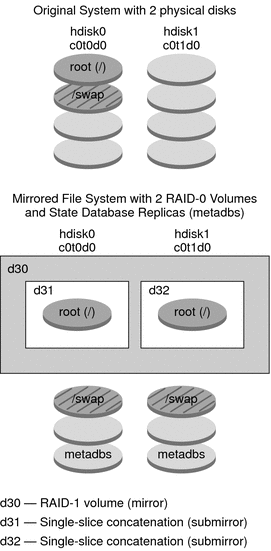Example of RAID-1 Volume Disk Layout
The following figure shows a RAID-1 volume that duplicates the root file system
(/) over two physical disks. State database replicas (metadbs) are placed on both
disks.
Figure 8-2 RAID-1 Volume Disk Layout

Figure 8-2 shows a system with the following configuration.
The mirror that is named d30 consists of the submirrors that are named d31 and d32. The mirror, d30, duplicates the data in the root (/) file system on both submirrors.
The root (/) file system on hdisk0 is included in the single-slice concatenation that is named d31.
The root (/) file system is copied to the hard disk named hdisk1. This copy is the single-slice concatenation that is named d32.
State database replicas are created on both slices: hdisk0 and hdisk1.
